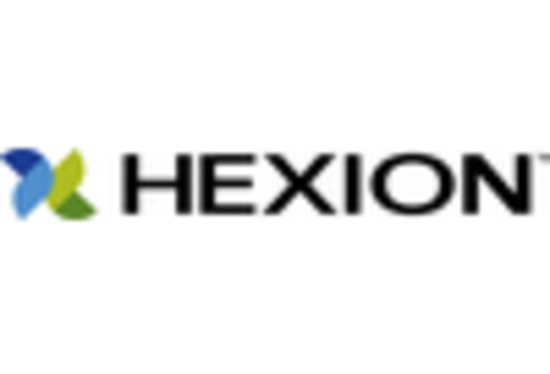Expansion of End-User Industries
The expansion of end-user industries such as electronics, marine, and construction is driving the growth of the Epoxy Hardener Market. As these sectors evolve, the need for high-performance materials that can withstand extreme conditions is becoming increasingly apparent. For instance, the electronics industry is experiencing a shift towards miniaturization and increased functionality, which necessitates the use of advanced materials like epoxy hardeners in circuit boards and encapsulation. Additionally, the marine industry is focusing on durable coatings and adhesives to enhance the longevity of vessels. This diversification of applications is likely to create new opportunities for manufacturers within the Epoxy Hardener Market, as they adapt their offerings to meet the specific needs of various end-user sectors.
Rising Demand in Construction Sector
The construction sector is experiencing a notable surge in demand for epoxy hardeners, driven by the increasing need for durable and high-performance materials. As infrastructure projects expand, the Epoxy Hardener Market is witnessing a significant uptick in usage, particularly in flooring, coatings, and adhesives. According to recent data, the construction industry is projected to grow at a compound annual growth rate of approximately 5.5% over the next few years, which is likely to bolster the demand for epoxy hardeners. This growth is attributed to the material's superior adhesion properties and resistance to chemicals and moisture, making it an ideal choice for various applications. Consequently, the Epoxy Hardener Market is poised to benefit from this trend, as manufacturers adapt to meet the evolving needs of the construction sector.
Growing Demand for Composite Materials
The increasing utilization of composite materials across various industries is significantly influencing the Epoxy Hardener Market. Composites, known for their lightweight and high-strength characteristics, are being adopted in sectors such as aerospace, construction, and sports equipment. The demand for epoxy hardeners, which serve as essential components in composite manufacturing, is likely to rise as industries seek to enhance product performance and reduce weight. Recent market analyses suggest that the composite materials market is projected to grow at a compound annual growth rate of approximately 6% over the next few years, which could positively impact the epoxy hardener segment. As the trend towards lightweight and durable materials continues, the Epoxy Hardener Market is expected to capitalize on this growing demand.
Increased Adoption in Automotive Applications
The automotive industry is increasingly adopting epoxy hardeners due to their excellent mechanical properties and ability to withstand harsh environmental conditions. The Epoxy Hardener Market is likely to see substantial growth as automotive manufacturers seek materials that enhance vehicle performance and longevity. Recent statistics indicate that the automotive sector is expected to grow at a rate of around 4% annually, which may drive the demand for advanced materials like epoxy hardeners. These hardeners are utilized in various applications, including coatings, adhesives, and composite materials, which are essential for modern vehicle manufacturing. As the automotive industry continues to innovate, the Epoxy Hardener Market is expected to expand in tandem, providing manufacturers with opportunities to develop new formulations tailored to specific automotive requirements.
Technological Innovations in Product Development
Technological advancements are playing a crucial role in shaping the Epoxy Hardener Market. Innovations in formulation and production processes are leading to the development of high-performance epoxy hardeners that offer enhanced properties such as faster curing times and improved thermal stability. These advancements are likely to attract a broader range of applications across various industries, including aerospace, electronics, and marine. The introduction of bio-based epoxy hardeners is also gaining traction, aligning with sustainability trends and consumer preferences for eco-friendly products. As manufacturers invest in research and development, the Epoxy Hardener Market is expected to evolve, providing solutions that meet the demands of modern applications while maintaining performance standards.

















Leave a Comment